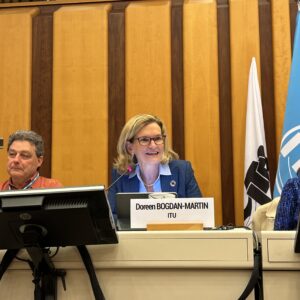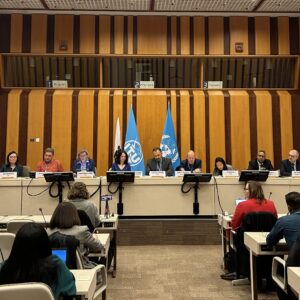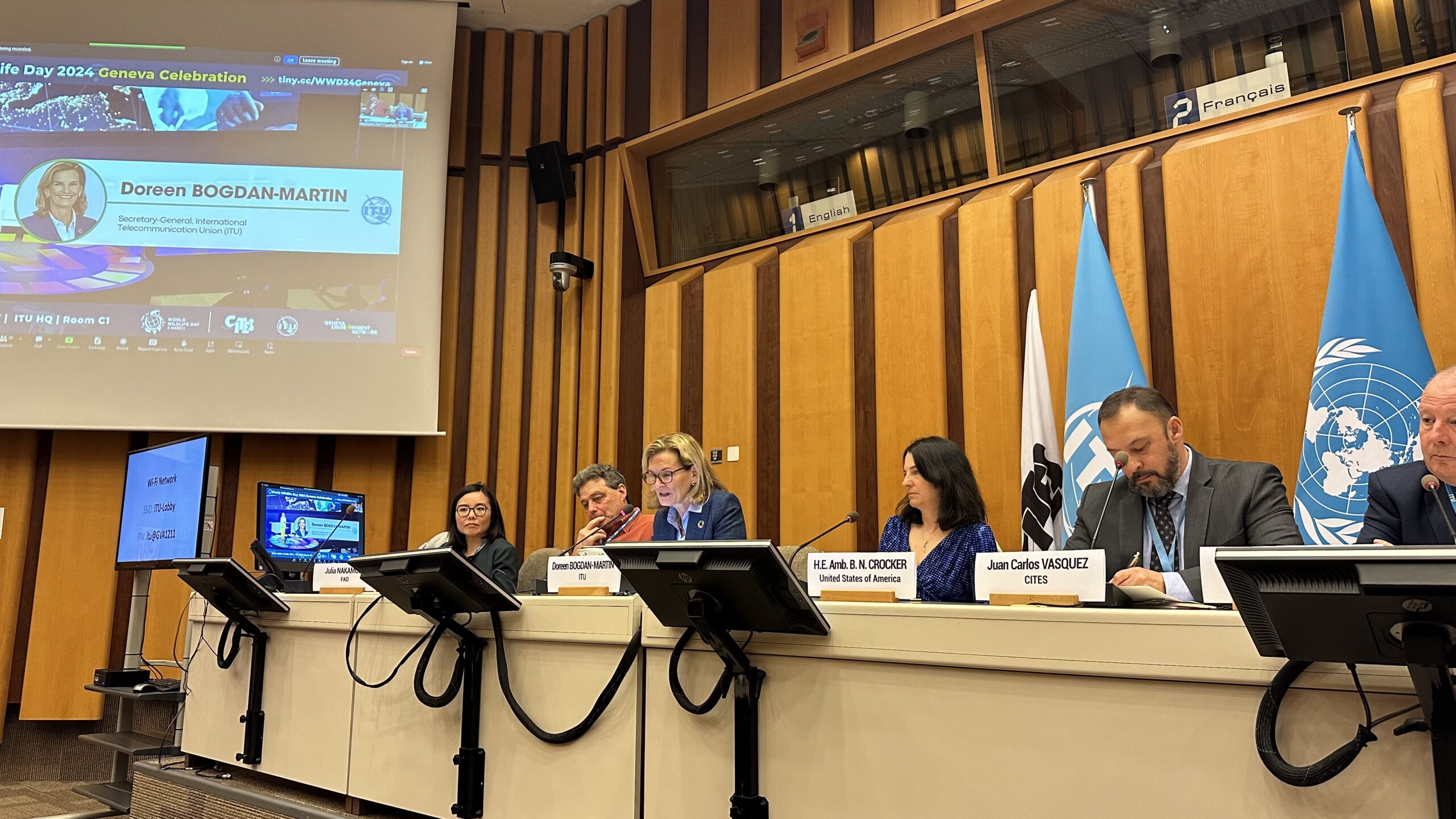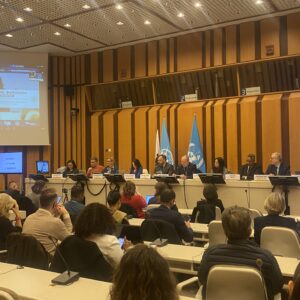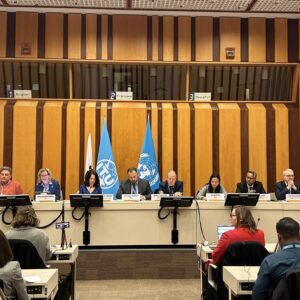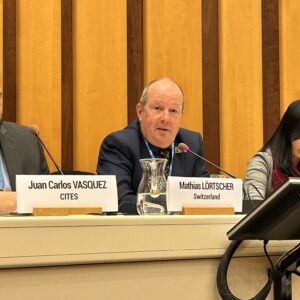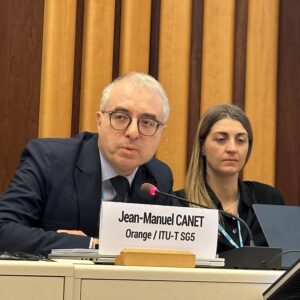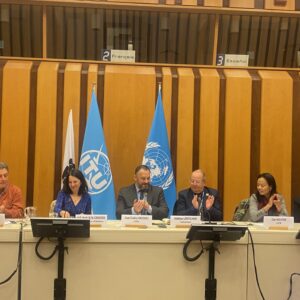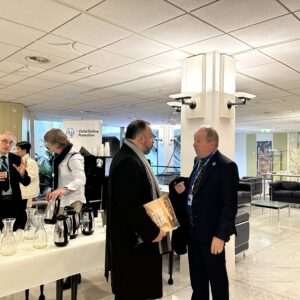Event Conference
World Wildlife Day 2024 Geneva Celebration | Connecting People and Planet: Exploring Digital Innovation in Wildlife Conservation

04 Mar 2024
14:30–16:00
Venue: Room C1 | ITU Headquarters
Organization: Convention on International Trade in Endangered Species of Wild Fauna and Flora, Geneva Environment Network, International Telecommunication Union
The Geneva World Wildlife Day 2024 Celebration highlighted the role of Geneva in bridging conservation and digital technology, and advancing digital innovation in the field of conservation and trade.

About this Event
On 20 December 2013, at its 68th session, the United Nations General Assembly proclaimed 3 March as World Wildlife Day to celebrate and raise awareness of the world’s wild fauna and flora. This date is also the day of the adoption in Washington of the Convention on International Trade in Endangered Species of Wild Fauna and Flora (CITES) in 1973, which plays an important role in ensuring that international trade does not threaten the survival of species listed in the CITES Appendices.
The theme of the United Nations World Wildlife Day 2024, “Connecting People and Planet: Exploring Digital Innovation in Wildlife Conservation”, aims to raise awareness about the latest applications of digital technologies in wildlife conservation and trade and about the impact of digital interventions on ecosystems and communities around the world. The celebrations will explore digital innovation and highlight how digital technologies and services can drive wildlife conservation and human-wildlife coexistence, now and for future generations in an increasingly connected world.
In recent years, important leaps in technology have allowed information and communication technologies (ICTs) not solely to have a negative impact on the environment but to become powerful instruments for tackling illegal wildlife trade and supporting conservation. Since 2020, the International Union for Conservation of Nature leads the Tech4Nature, a global partnership to scale up success in nature conservation through digital technology innovation developed together with Huawei. In 2023, the International Telecommunications Union (ITU) launched an AI for Biodiversity series exploring the role of AI to monitor biodiversity and support conservation actions. From satellite images for monitoring to AI technologies to enhance understanding, identification, and protection, digital innovation can strengthen the sustainability and traceability of trade and combat illegal trade in wildlife.
Digital solutions can support the automate National laws for implementing the Convention and relevant parts of Legal Acquisition Findings (LAFs). Therefore, the CITES Secretariat, in collaboration with the Food and Agriculture Organization (FAO), has developed CITES-LEX, a new information system that provides national catalogues and comprehensive search capabilities of legislation and policies relevant to the implementation of the Convention, to be launched on World Wildlife Day.
In line with the World Wildlife Day 2024 United Nations event taking place in New York, the CITES Secretariat, ITU and the Geneva Environment Network are organizing a celebration that highlights the role of Geneva in making advances in the field as host of both the CITES Secretariat and ITU, frontrunners in bridging conservation and digital technology, as well as to many other actors engaged in advancing digital innovation in the field of conservation and trade.
The event was followed by a light reception.
Speakers

Doreen BOGDAN-MARTIN
Secretary-General, International Telecommunication Union (ITU)
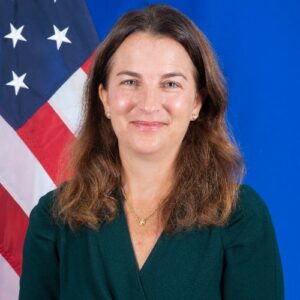
H.E. Amb. Bathsheba Nell CROCKER
Permanent Representative of the United States to the United Nations Office at Geneva
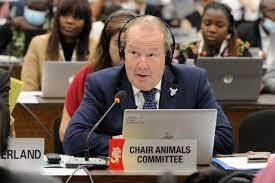
Mathias LÖRTSCHER
Head, Convention on International Trade in Endangered Species of Wild Fauna and Flora (CITES) Management Authority, Switzerland
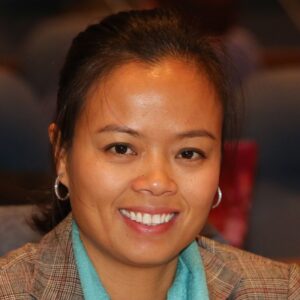
Dao NGUYEN
Senior Programme Manager, Conservation Action, International Union for Conservation of Nature (IUCN)

John DAVID
Information Systems Officer, Automated System for Customs Data, United Nations Conference on Trade and Development (UNCTAD)

Jean-Manuel CANET
Senior Manager, Climate and Biodiversity, Orange Group | Vice-chair of ITU-T SG5 “EMF, Environment, Climate action, Sustainable Digitalization, and Circular Economy

Simone HAYSOM
Director, Environmental Crime and Head, ECO-SOLVE, Global Initiative Against Transnational Organized Crime

Esther GITHINJI
East Africa Conservation Technology Coordinator, WILDLABS

Swabir ABDULREHMAN
Technical Director, Connected Conservation Foundation

Bourhan YASSIN
CEO, Rainforest Connection
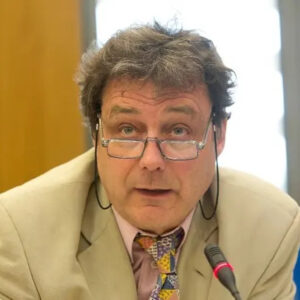
Bertrand von ARX
Director, Biodiversity, Canton of Geneva

Julia NAKAMURA
Legal Officer, Food and Agriculture Organization of the United Nations (FAO)
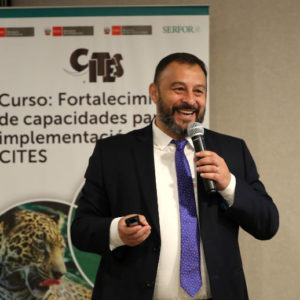
Juan Carlos VASQUEZ
Chief, Legal Affairs and Compliance, Convention on International Trade in Endangered Species of Wild Fauna and Flora (CITES) | Moderator
Highlights
Video
Summary
Opening Remarks
Doreen BOGDAN-MARTIN | Secretary-General, International Telecommunication Union
- ITU is working together with CITES and GEN, putting spotlight on how digital innovation can help to forge a stronger and more sustainable connections between people and planet.
- One of the ITU’s core competencies, the International Technical standards, is enabling all the biodiversity monitoring systems and conservation management systems to exchange data seamlessly. The standards also help us and companies to track and hence reduce the environmental impact of the tech footprint.
- ITU launched an AI for biodiversity series in 2023 to explore how AI can support biodiversity monitoring and conservation actions.
H.E. Amb. Bathsheba Nell CROCKER | Permanent Representative of the United States to the United Nations Office at Geneva
- In the United States, the US Fish and Wildlife Forensics Laboratory is the only federal crime lab devoted to criminal investigation of wildlife crimes, is at the forefront of the US’s efforts.
- The Government of the United States of America has committed more than USD 125 million annually in recent years to combat wildlife trafficking around the world. The US Fish and Wildlife Service in partnership with the US Department of State offers a wildlife trafficking cyber-crime training course for enforcement officials around the world.
Mathias LÖRTSCHER | Head of CITES Management Authority, Switzerland
- We are celebrating the 51st birthday of CITES, the Convention on the International Trade in Wild Fauna and Flora. This convention for the past 51 years has controlled and regulated international trade in endangered species. By doing so, it has promoted and safeguarded a lot of species from extinction. It has even made very positive contributions to conservation by doing its work.
Panel Discussion / Hackaton
Dao NGUYEN | International Union for Conservation of Nature
- IUCN and Huawei have a global partnership on Tech4Nature initiative, with a vision to scale up the use of digital technologies to drive the effective and equitable management of protected and conserved areas. Entering the second phase of partnership, the goal is to successfully conserve species and ecosystems through fair and effective management, and monitoring activities, using technology, as measured against the IUCN Green List.
- The objectives of Tech4Nature initiative are: bridging the gap between science and conservation action; identification and protection of critical habitats; effective management of protected areas; global impact and collaboration; supporting the Kunming-Montreal Global Biodiversity Framework; species monitoring and protection; community involvement in conservation; efficiency and effectiveness in conservation; Transparency, inclusivity, and responsibility.
- Nguyen also shared five success stories of the initiative, ranging from species, marine, wetland, mountain, and urban, across countries such as China, Mauritius, Mexico, Switzerland, Spain, and more.
John DAVID | UNCTAD-ASYCUDA
- The eCITES solution is a joint initiative between the CITES Secretariat and UNCTAD-ASYCUDA program. David introduced the timeline of eCITES establishment and the progress over the years. He pointed out that the first ASYCUDA eCITES solution was implemented in Sri Lanka, followed by Mozambique. He shared the systems is based on international standards. He further noted that solution covers the cycle of implementation, including ePermit application and issuance, eControl, eReport, and eExchange.
Jean-Manuel CANET | Orange Consulting, Vice-chair of ITU-T SG5 “Environment, EMF and Circular Economy”
- Canet presented on how ITU standards can foster actions. He introduced the ITU-T Study Group 5 on environment climate biodiversity, which develops international standards on biodiversity under the standardization section of the ITU.
- The ITU-T Study Group 5 has 2 recommendations under development. The first recommendation is about biodiversity footprint, aiming to assess the footprint of an ICT organization on biodiversity, with a focus on the analysis of pressure points on ecosystem, comparing onsite and aggregated levels.
- The second recommendation focuses on biodiversity opportunities. It entails providing evaluating the secondary effects of ICT solutions on biodiversity. This includes assessing the positive impacts to provide quantified proof of the impact of the usage of AI, and more digital technologies, to identify biodiversity opportunities.
Simone HAYSOM | ECO-SOLVE, Global Initiative Against Transnational Organized Crime
- Haysom presented on using AI to track cyber wildlife trafficking. The data collection process adopted a mixed methodology, including both automated (AI/ML) and manual. She also gave an update on the data hubs of their global monitoring system for cyber wildlife trafficking.
- The objectives included disrupting criminal networks; building technologically empowered networks of response; feeding data into global policy and shaping debate; creating global public goods databases and algorithms.
Esther GITHINJI | WILDLABS
- Wildlabs is the first global, open online community dedicated to conservation technology. Githinji gave an introduction on the Wildlabs Tech4Wildlife photo challenge and a set of examples of photos with their stories, as well as the training program of women in conservation technology.
Swabir ABDULREHMAN | Connected Conservation Foundation
- Abdulrehman introduced the satellite for biodiversity program, one of the flagship initiatives of CCF, that secured connectivity for 19 African parks. He also gave an update on the NRT community conservation, a community conservatory set up in Northern Kenya.
Bourhan YASSIN | Rainforest Connection
- Yassin introduced the spectrogram, a 2D representation of an audio clip. By articulating the information included in the 30-second clip recorded in Panama, he showcased the usage of AI in bio-acoustics in wildlife conservation. He also gave an introduction of the guardian, a digital device installed on top of the tree canopy that can record and analyze the sound 24/7, and send the audio to the cloud for further analysis, as an example of passive acoustic monitoring.
Bertrand VON ARX | Canton of Geneva
- Canton of Geneva is an openair lab with rich biodiversity. Arx presented a set of artefacts as examples, such as Geneva’s natural habitat map, Geneva’s green infrastructure, Geneva’s dark infrastructure, Camera traps for wild fauna management, etc., to showcase the usage of geometic technological tools that provides evidence for decision making in Geneva and for us to reflect on the connection between humanity and nature.
Launch of CITE-Lex
Julia NAKAMURA | FAO
- Nakamura announced the launch of CITES-LEX, the new information system that provides national catalogues and comprehensive search capabilities of legislation policies relevant to the implementation of CITES, as the product from the collaboration between the development of law service of the legal office of FAO and CITES Secretariat. The CITES illegal trade database, FAO-LEX and ECO-LEX are also integrated in this database. Users can search legislation using keywords, countries, regions etc.
Photo Gallery
Documents
- Presentions made during the event
- H.E. Amb. Bathsheba Nell CROCKER Statement
- Photos of the event by US Mission
- Photos of the event by ITU
Links
- World Wildlife Day Official Website
- World Wildlife Day 2024 | CITES Press Release | 29 November 2023
- Celebrating World Wildlife Day in Geneva and Beyond
- CITES-LEX | CITES and FAO
- Tech4Nature | IUCN
- eCites | CITES and UNCTAD-ASYCUDA
- WILDLABS.NET
- ECO-SOLVE | European Union’s Global Illicit Flows Programme & Global Initiative Against Transnational Organized Crime (GI-TOC)
- The State of Conservation Technology 2023: Five Key Findings | WILDLABS.NET | 15 November 2023
- Guidance for ICT Companies Setting Science-Based Targets | ITU | 2020

